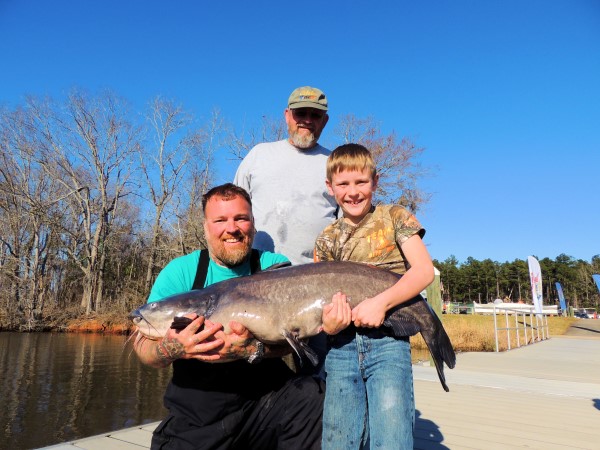by Brad Hierstetter
The sport of recreational trophy catfishing has grown at an impressive rate over the last two decades. During this time, the number of anglers who pursue larger catfish has increased considerably, a trend that industry has recognized.

 Two tournaments held this year, on the same September weekend, exemplify increased angler and industry interest in trophy catfishing. On the Ohio River, 329 anglers participated in the 11th Annual Ohio River Cats Catfish Tournament. To the South, more than 180 boats fished the Mississippi River Monsters Tournament, which was sponsored by over thirty-five industry partners.
Two tournaments held this year, on the same September weekend, exemplify increased angler and industry interest in trophy catfishing. On the Ohio River, 329 anglers participated in the 11th Annual Ohio River Cats Catfish Tournament. To the South, more than 180 boats fished the Mississippi River Monsters Tournament, which was sponsored by over thirty-five industry partners.
 Despite the sport’s growth, many people, for various reasons, still refuse to recognize the importance of protecting recreational catfisheries. Activities underway in many states, some of which are Government-sanctioned, are jeopardizing some of our nation’s finest public trophy catfish waters. Some fisheries managers consider trophy catfish a threat to native species and many people still hold the antiquated belief that catfish are “trash” fish, not game fish.
Despite the sport’s growth, many people, for various reasons, still refuse to recognize the importance of protecting recreational catfisheries. Activities underway in many states, some of which are Government-sanctioned, are jeopardizing some of our nation’s finest public trophy catfish waters. Some fisheries managers consider trophy catfish a threat to native species and many people still hold the antiquated belief that catfish are “trash” fish, not game fish.
In these waters, especially those where trophy catfish are not indigenous, some state fisheries managers have labeled trophy catfish a significant threat to native species – thus the adjective “invasive” or “nuisance.” As a result, steps have been taken to limit the expansion of trophy catfish populations and/or to reduce their overall numbers.
In Maryland, for example, anglers are encouraged by the Department of Natural Resources to “remove and kill any blue and flathead catfish they catch.” Maryland also permits blue catfish to be removed from its waters and transported live to destinations outside of Maryland, with no restrictions on size or numbers.
Paylakes stocked with catfish taken from public waters pose a considerable risk too. They are arguably the most significant threat to our trophy catfish fisheries. Paylakes are privately owned and many are stocked with catfish removed from public waters by licensed commercial anglers who capture catfish using gill nets, hoop nets, and trotlines. These commercial anglers sell their catches to paylake owners or to people who provide live fish to paylake owners. These owners routinely pay a premium rate per-pound for trophy-sized catfish and charge constituents a fee in exchange for permission to fish their stocked lakes.
The habitat in most paylakes is vastly different than, and inferior to, habitat present in the fish’s source waters. The health of most catfish uprooted from public waters and relocated to paylakes quickly deteriorates and a very high number succumb to early deaths. Many of the larger fish are ten years of age or older. Reports posted by education-oriented groups, such as Exposing Paylakes, provide reliable documentation of hundreds of thousands of pounds of catfish being transplanted from public waters to paylakes each year.
Now, more than ever, recreational catfish anglers must unite in support of formal measures that will protect and conserve our public trophy catfisheries. Recreational anglers must accept this REALITY: in the absence of a visible contingent of trophy catfish advocates, the actions of those who do not view trophy catfish favorably will, invariably, harm the public catfisheries that are so near and dear to our hearts.
I challenge everyone who enjoys catfishing to publicly and actively support catfish conservation. This includes those anglers who fish purely for fun, tournament anglers – including those with formal sponsorships – members of catfishing clubs, catfishing guides, owners of catfishing-related businesses, and members of the media.
Speaking both practically and generally, the amount of time necessary to be a meaningful conservationist is minimal. A few simple, yet productive, actions that you can take include: supporting groups with a conservation focus; asking your local fisheries managers to implement and enforce measures to discourage the transportation of trophy catfish from public waters to paylakes; consistently practicing Catch, Photograph, and Release (C.P.R.) of larger fish; and harvesting selectively.
Whatever action you take, do not knowingly leave the fate of our great sport up to others. Engage now and do your part to ensure that future generations can experience excellent trophy catfishing.



